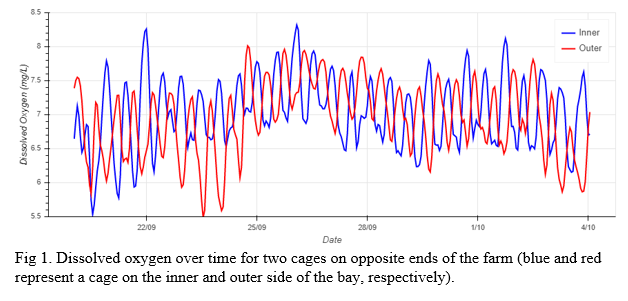REAL-TIME DISSOLVED OXYGEN MONITORING IN A NOVA SCOTIA ATLANTIC SALMON FARM
As the global population continues to grow and fisheries collapse, the sustainable growth of aquaculture is more important now than ever. Traditional land farming has had centuries to develop new technologies especially through the “Green Revolution” of the mid-20th century; the next logical step is for a “Blue Revolution” to match that. Recently, an important area of focus for technological advances has been on water quality monitoring to improve aquaculture management. For example, farmers can now employ dissolved oxygen sensors that report in real-time to monitor their farms with precision; however, their use is still in its infancy and further research is needed to fully operationalize them. In this study, 60 InnovaSea, real-time dissolved oxygen and temperature sensors were distributed throughout 19 cages at a salmon farm located within Shelburne Bay, Nova Scotia (Canada). The dense deployment allowed for insight into the spatial and temporal variability of dissolved oxygen throughout a farm. Tide was determined to have the most significant impact on dissolved oxygen levels, with its influence varying depending on cage location within the farm. As highly oxygenated waters flow from one end of the farm to the other, driven by tidal advection, fish respiration and flow restriction from cage infrastructure reduce oxygen levels. This results in oxygen concentration out of phase in opposite sides of the farm, with high oxygen levels at one end of the farm and low oxygen levels at the other (Figure 1). Since farmers use low oxygen as an indicator as to whether to feed, it is important to understand oxygen dynamics through the farm and across cages to make informed decisions that impact fish growth and welfare.
